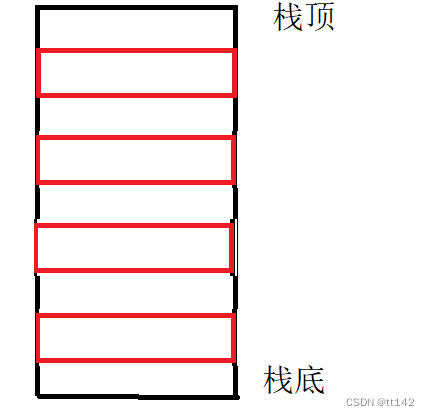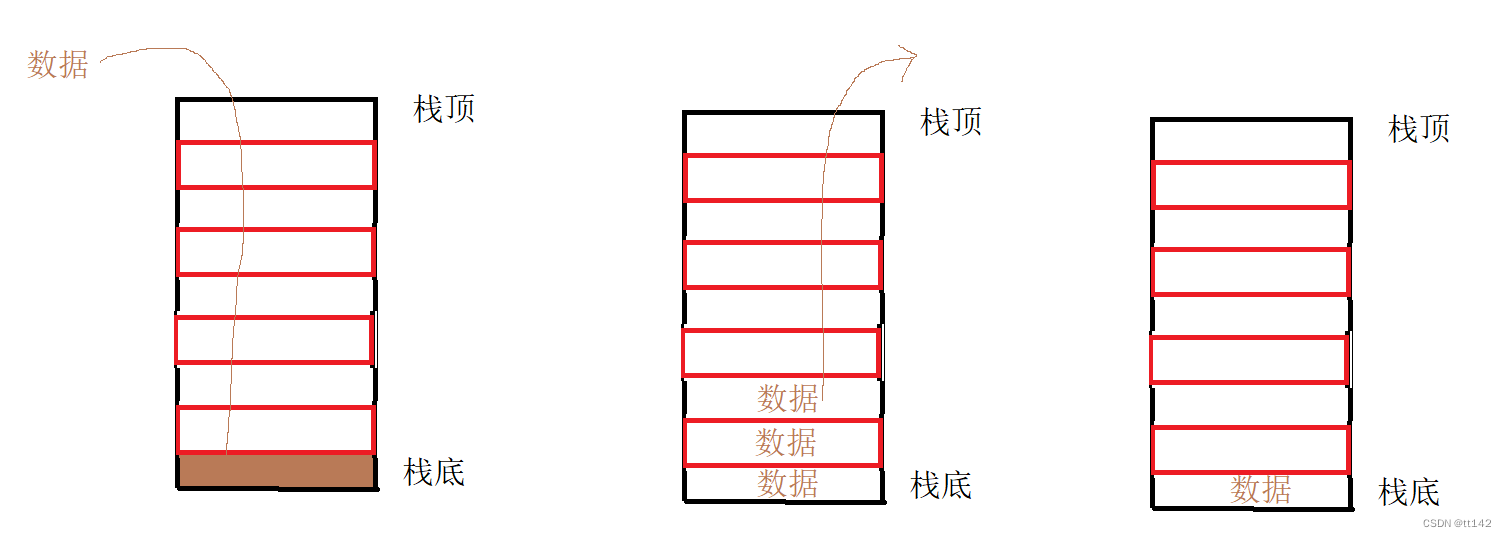-
【C++】栈~~(很详细哦)
在前几天,我们刚一起学过顺序表,链表(无头单向不循环,有头双向循环),这两种都属于线性表因为是一系列存储的。而以后的哈希表则是散列表
今天我们看一下栈

目录
1.栈的介绍
栈,又叫做栈帧,也是一种数据结构(和顺序表链表一样),但是他自己的结构也有一些特殊的地方

他是这样的,我们把底部叫做栈底,顶部叫做栈顶,通俗易懂对吧,但是他有一个小规则,只能从栈顶存储或者销毁数据,如果现在有一个空栈,那么存储删除数据就是下面这样的

永远不可能从栈底拿出数据,没有为什么~~
或者你也可以总结成LIFO原则(last in first out)即后进先出
2.实现
不难发现,其实他的结构和之前学过的顺序表 链表很相似,我们已经写过两个了,这个可不可以仿照着写呢?那模仿哪一个更好?
分析一下啦
首先他不存在不连续存储的问题,在这点上其实二者(顺序表,链表)都行,但是既然都连续存储了还是顺序表更方便一下,不需要指针指来指去
其次最好可以很方便的访问数据,而且能快速进行一个位置(栈顶或者栈底)的增删,因为栈的结构就决定他只需要一个位置增删就可以,那就是顺序表的下标访问最合适不过了~~~
所以我们采取顺序表的写法来写栈
对于顺序表不了解的同学赶紧去看看我的顺序表那篇文章在下面
头文件
- #pragma once
- #include
- #include
- #include
- #include
- typedef int type;
- typedef struct Stack
- {
- type *a;
- int top;// 初始化成0 表示栈顶位置下一个位置的下标
- int capacity;
- }ST;
- void InitST(ST* p);//初始化
- void PushST(ST* p,type x);//在栈顶压数据
- void PopST(ST* p);//从栈顶删除数据
- void DestoryST(ST* p);//销毁栈
- bool Empty(ST* p);//判断栈是不是空
- type StackTop(ST* p);//显示栈顶的数据
- type SizeST(ST* p);//栈里面数据的个数
实现
- #include "stack.h"
- void InitST(ST* p)//初始化
- {
- type* tmp = (type*)malloc(sizeof(type)*4);
- if (tmp == NULL)
- {
- perror("InitST");
- exit(-1);
- }
- p->a = tmp;
- p->capacity = 4;
- p->top = 0;
- }
- void PushST(ST* p, type x)//在栈顶压数据
- {
- if (p->capacity == p->top)//表示需要扩容
- {
- ST* tmp = (ST*)realloc(p->a, p->capacity* 2*sizeof(type));
- if (tmp == NULL)
- {
- perror("realloc");
- exit(-1);
- }
- p->a = tmp;
- p->capacity *= 2;
- }
- p->a[p->top] = x;
- p->top++;
- }
- void PopST(ST* p)//从栈顶删除数据
- {
- assert(p);
- assert(!Empty(p));
- p->top--;
- }
- void DestoryST(ST* p)//销毁栈
- {
- assert(p);
- free(p->a);
- p->a = NULL;
- p->capacity = p->top = 0;
- }
- bool Empty(ST* p)//判断栈是不是空
- {
- assert(p);
- return p->top == 0;
- }
- type StackTop(ST* p)//显示栈顶的数据
- {
- assert(p);
- assert(!Empty(p));
- return p->a[p->top - 1];
- }
- type SizeST(ST* p)//栈里面数据的个数
- {
- assert(p);
- return p->top;
- }
3.题目
题目在这里大家先自己做一下
我们用C语言写一下,其实就是匹配的问题,如果都是左括号比如(,{,【,这些都是要压栈的,不需要遍历到结束再去判断是否匹配的问题,只要遇到右括号就及时匹配就好了
因为是C语言写的所以需要在前面把我们写的栈带上
- typedef int type;
- typedef struct Stack
- {
- type *a;
- int top;// 初始化成0 表示栈顶位置下一个位置的下标
- int capacity;
- }ST;
- bool Empty(ST* p)//判断栈是不是空
- {
- assert(p);
- return p->top == 0;
- }
- void InitST(ST* p)
- {
- type* tmp = (type*)malloc(sizeof(type)*4);
- if (tmp == NULL)
- {
- perror("InitST");
- exit(-1);
- }
- p->a = tmp;
- p->capacity = 4;
- p->top = 0;
- }
- void PushST(ST* p, type x)//在栈顶压数据
- {
- if (p->capacity == p->top)//表示需要扩容
- {
- type* tmp = (type*)realloc(p->a, p->capacity* 2*sizeof(type));
- if (tmp == NULL)
- {
- perror("realloc");
- exit(-1);
- }
- p->a = tmp;
- p->capacity *= 2;
- }
- p->a[p->top] = x;
- p->top++;
- }
- void PopST(ST* p)//从栈顶删除数据
- {
- assert(p);
- assert(!Empty(p));
- p->top--;
- }
- void DestoryST(ST* p)//销毁栈
- {
- assert(p);
- free(p->a);
- p->a = NULL;
- p->capacity = p->top = 0;
- }
- type StackTop(ST* p)//显示栈顶的数据
- {
- assert(p);
- assert(!Empty(p));
- return p->a[p->top - 1];
- }
- bool isValid(char * s){
- ST st;
- InitST(&st);
- while(*s)
- {
- if(*s=='(' || *s=='[' || *s=='{')
- {
- PushST(&st,*s);
- ++s;
- }
- else
- {
- if(Empty(&st))
- {
- DestoryST(&st);
- return false;
- }
- char top=StackTop(&st);
- PopST(&st);
- if((*s==')'&& top!='(' )||(*s==']'&& top!='[' )||( *s=='}'&&top!='{'))
- {
- DestoryST(&st);
- return false;
- }
- else{
- s++;
- }
- }
- }
- bool ret=Empty(&st);
- DestoryST(&st);
- return ret;
- }
大家学会了吗~~~
-
相关阅读:
Linux学习笔记9
JavaScript中内置对象的方法总结
IS200EPSMG1AED 使用Lua创建逻辑脚本或完整程序
lua环境搭建数据类型
Ambire 的柏林冒险之旅,快来一起看看团队带来的日志的剪报吧!
盐城北大青鸟告诉你:中考结束后还有这些事情要做
[附源码]Python计算机毕业设计Django绿色生鲜
王道数据结构二叉树算法大题代码总结
Open3D 进阶(10)使用FilterReg算法对点云配准
免费在线行为验证,保护你的账号安全
- 原文地址:https://blog.csdn.net/weixin_71138261/article/details/127775097
